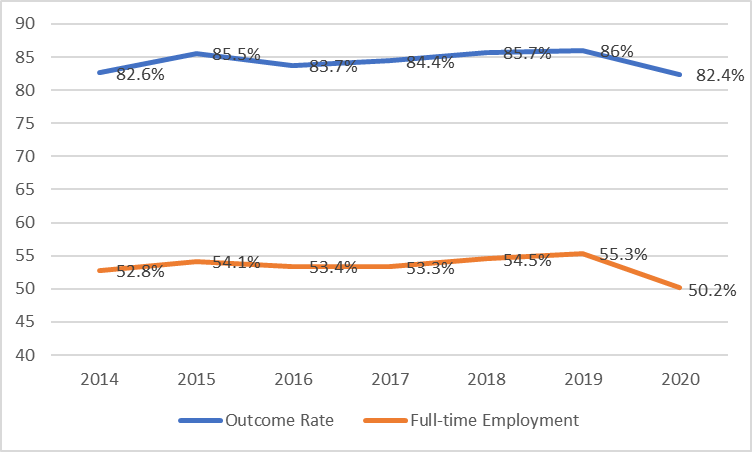Spotlight for Career Services Professionals
Spotlight for Recruiting Professionals
Definitions
Overall outcomes rate (aka career outcomes rate): The number of graduates who have landed in any of the employment categories, plus service and military, plus continuing education divided by the number of students for whom an outcome is known. It excludes those graduates identified as not seeking an outcome. Expressed mathematically, the career outcomes rate is: (# employed + # service + # military + # continuing education)/(# employed + # service + # military + # continuing education + # still seeking employment & continuing education).Traditional employment: A graduate works for an employer with relatively steady work hours, a defined wage/salary, and a presumption of benefits such as medical insurance.
Class of 2020 bachelor’s degree graduates experienced an unusual and disruptive final year. The COVID-19 pandemic threw the final months of their college careers into chaos as schools were forced to close to in-person classes, and graduations took place via Zoom instead of on campus.
The post-graduation experience of these new college graduates was also disrupted. They were introduced to a work world in an unprecedented economy, one steeped with uncertainties. Those who had acquired positions prior to graduation faced the prospect of possibly losing that position—because their expected employer needed to rescind the offer due to depressed business conditions—or a delay to their start date, as many employers hoped to get back to normal conditions after the spring/summer surge in the virus. In fact, NACE polling conducted during the spring 2020 graduation season found that slightly more than 4% of employers were rescinding offers made for full-time positions, and a large number—31%—expected to delay start dates for full-time recruits. Given these conditions, it will come as no surprise that the outcomes for the Class of 2020 differed markedly from the outcomes experienced by previous classes.
The percent of 2020 graduates experiencing a positive outcome decreased substantially—not only in comparison to their Class of 2019 counterparts, but in comparison to every class since 2014, when NACE first began reporting outcomes. (See Figure 1.)
Lowest Rate of Employment With Traditional Employer
Driving the decrease in positive outcomes was a sharp decline in the percent of 2020 graduates employed full time in traditional employment settings in comparison to previous years.
As Figure 1 illustrates, slightly more than half of the Class of 2020 had obtained a full-time position with a traditional employer within six months of graduating. This decline is particularly noteworthy when compared to the Class of 2019, with the percent employed full time dropping from more than 55% to just over 50%.
Taken together, the two declines underscore the level of disruption faced by the Class of 2020 graduates. In context, applying those rates to the approximately 2,000,000 bachelor’s degrees awarded in 2019 and 2020 results in 102,000 fewer graduates obtaining full-time employment with a traditional employer in 2020 as opposed to 2019.
First Destinations for the College Class of 2020 is available on NACEWeb and includes an interactive dashboard. It is the seventh in a series that began with the college class of 2014. The 2020 class year is defined as extending from July 1, 2018, through June 30, 2020. The survey for the class was conducted through individual colleges and universities nationwide, which then reported their results to NACE. The schools conducted the survey from graduation through December 30, 2020, and reported their data to NACE from January 6 through April 30, 2021. All data in the report are as of December 30, 2020. In total, NACE received reports from 342 schools; they reported outcomes for graduating classes totaling more than 757,000 students in four degree programs—associate, bachelor’s, master’s, and doctoral-level programs. Results for previous classes can be accessed on the NACE website.
Figure 1: First Destinations – Class of 2020: Outcome and Employment Trends

Source: First Destinations for the College Class of 2020, National Association of Colleges and Employers






